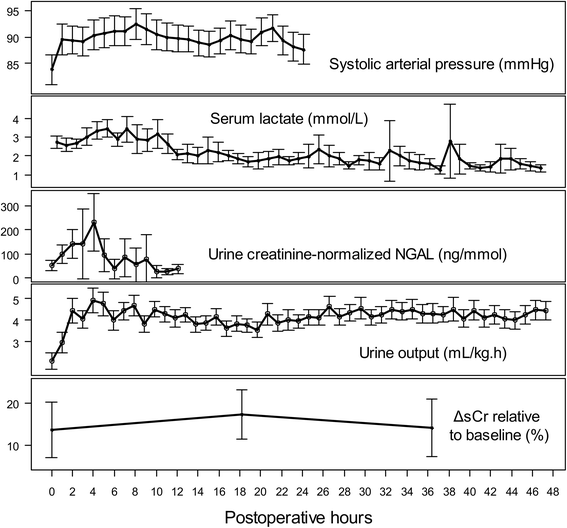Structural equation modelling exploration of the key pathophysiological processes involved in cardiac surgery-related acute kidney injury in infants
- PMID: 27262736
- PMCID: PMC4893417
- DOI: 10.1186/s13054-016-1350-1
Structural equation modelling exploration of the key pathophysiological processes involved in cardiac surgery-related acute kidney injury in infants
Abstract
Background: Uncertainties about the pathophysiological processes resulting in cardiac surgery-related acute kidney injury (AKI) in infants concern the relative impact of the most prominent risk factors, the clinical relevance of changes in glomerular filtration rate vs tubular injury, and the usefulness of available diagnostic tools. Structural equation modelling could allow for the assessment of these complex relationships.
Methods: A structural model was specified using data from a prospective observational cohort of 200 patients <1 year of age undergoing cardiopulmonary bypass surgery. It included four latent variables: AKI, modelled as a construct of perioperative creatinine variation, of oliguria and of urine neutrophil gelatinase-associated lipocalin (uNGAL) concentrations; the cardiopulmonary bypass characteristics; the occurrence of a post-operative low cardiac output syndrome and the post-operative outcome.
Results: The model showed a good fit, and all path coefficients were statistically significant. The bypass was the most prominent risk factor, with a path coefficient of 0.820 (95 % CI 0.527-0.979), translating to a 67.2 % explanation for the risk of AKI. A strong relationships was found between AKI and early uNGAL excretion, and between AKI and the post-operative outcome, with path coefficients of 0.611 (95 % CI 0.347-0.777) and 0.741 (95 % CI 0.610-0.988), respectively. The path coefficient between AKI and a >50 % increase in serum creatinine was smaller, with a path coefficient of 0.443 (95 % CI 0.273-0.596), and was intermediate for oliguria, defined as urine output <0.5 ml kg(-1) h(-1), with a path coefficient of 0.495 (95 % CI 0.250-0.864). A path coefficient of -0.229 (95 % CI -0.319 to 0.060) suggested that the risk of AKI during the first year of life did not increase with younger age at surgery.
Conclusions: These findings suggest that cardiac surgery-related AKI in infants is a translation of tubular injury, predominately driven by the cardiopulmonary bypass, and linked to early uNGAL excretion and to post-operative outcome.
Trial registration: ClinicalTrials.gov identifier NCT01219998 . Registered 11 October 2010.
Keywords: Acute kidney injury; Cardiopulmonary bypass; Paediatric cardiac surgery.
Figures


Comment in
-
qSOFA does not replace SIRS in the definition of sepsis.Crit Care. 2016 Jul 17;20(1):210. doi: 10.1186/s13054-016-1389-z. Crit Care. 2016. PMID: 27423462 Free PMC article. No abstract available.
-
Latent AKI is… still AKI: the quantification of the burden of renal dysfunction.Crit Care. 2016 Aug 26;20(1):238. doi: 10.1186/s13054-016-1428-9. Crit Care. 2016. PMID: 27561544 Free PMC article.
References
Publication types
MeSH terms
Substances
Associated data
LinkOut - more resources
Full Text Sources
Other Literature Sources
Medical

